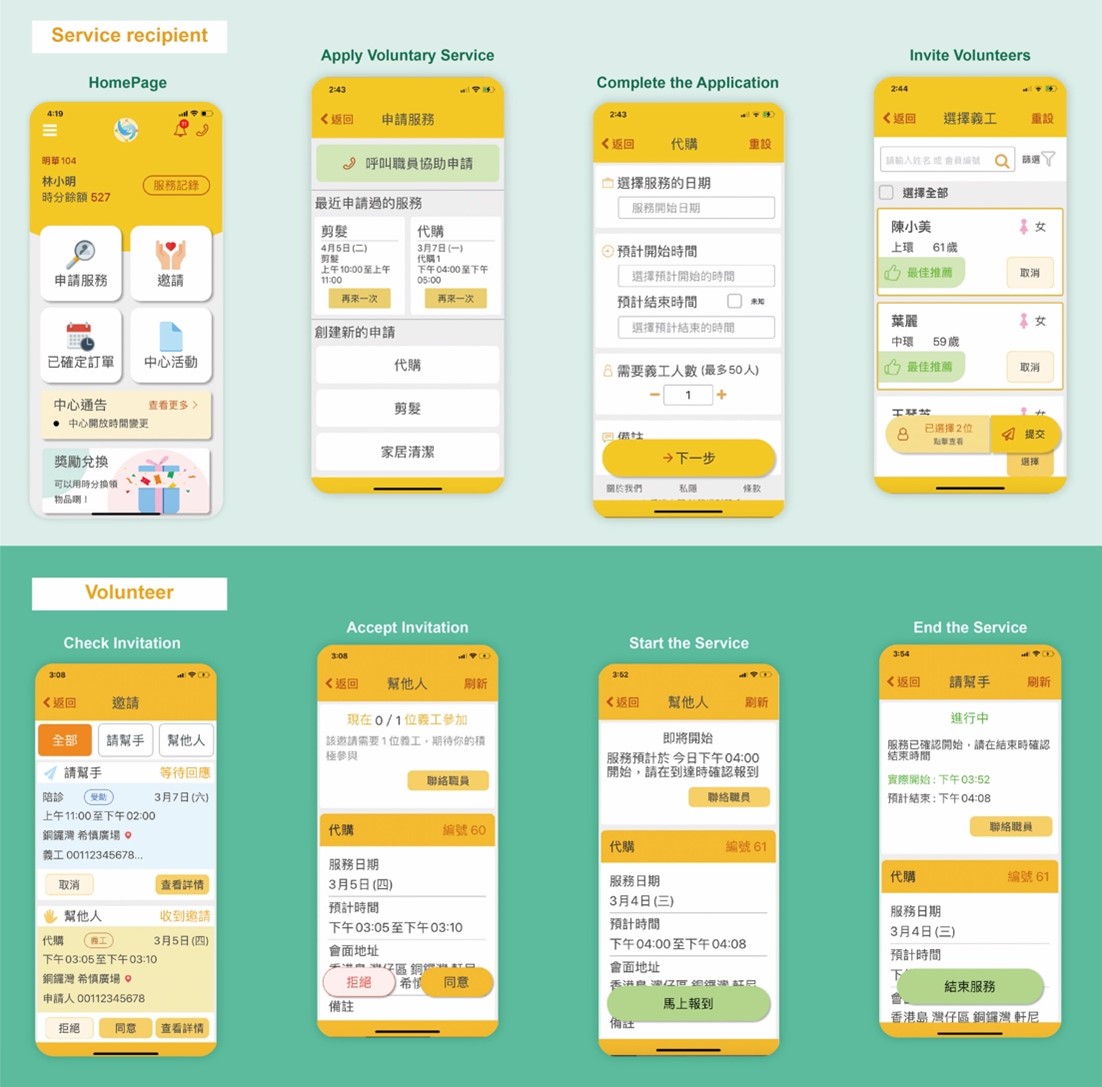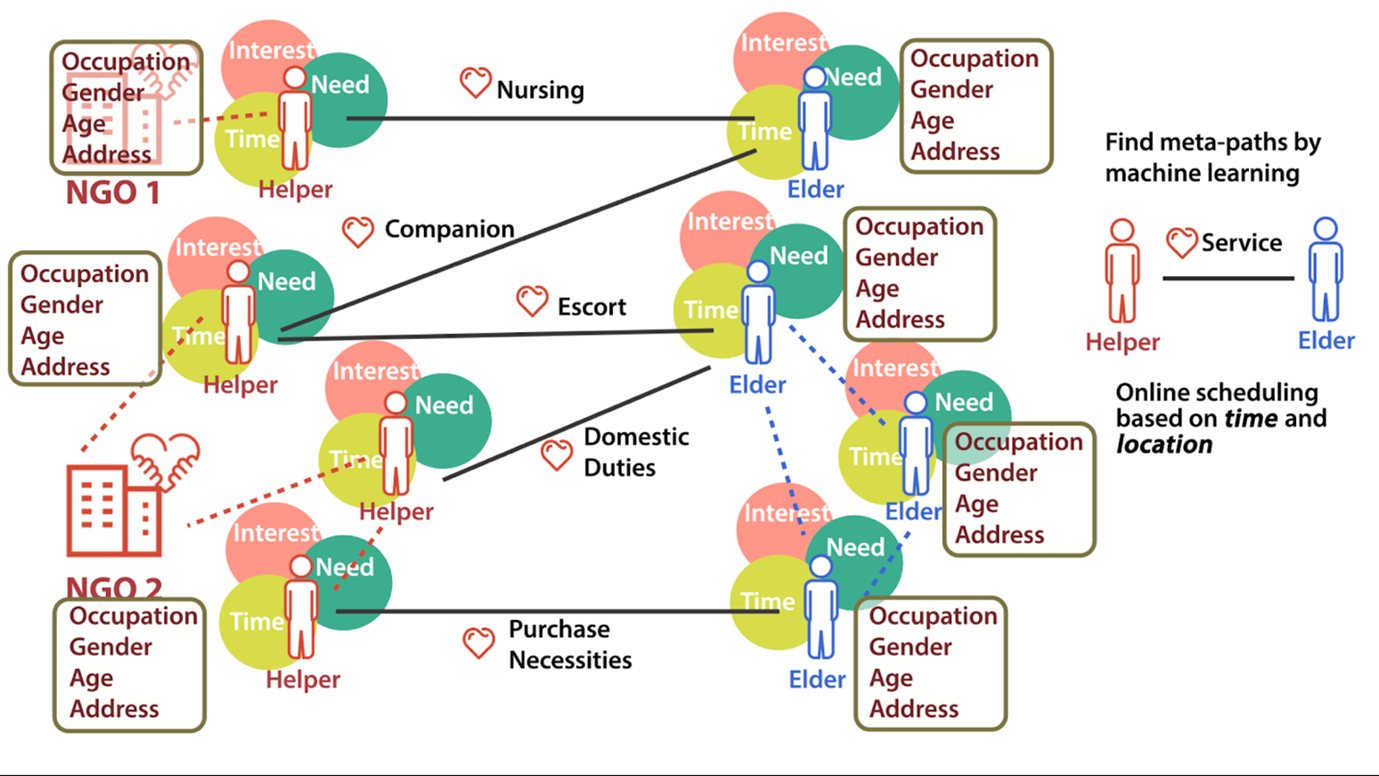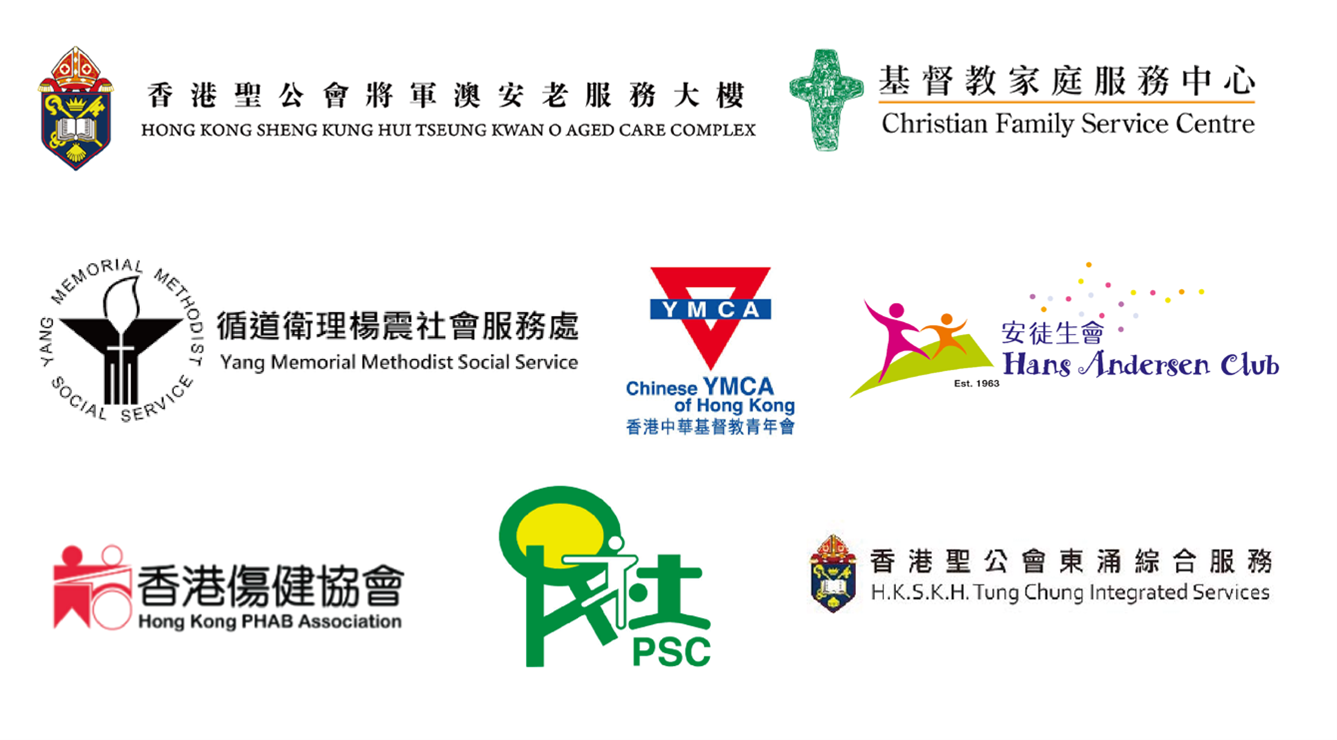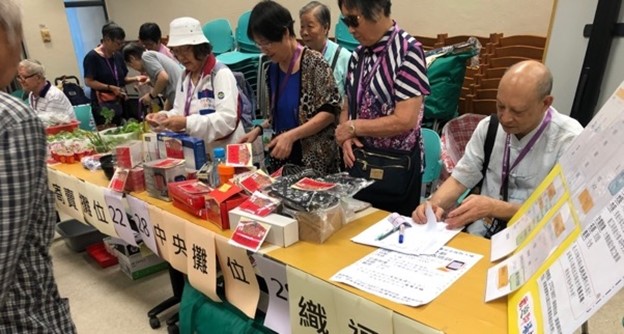Background
In Hong Kong, the number of elderly citizens is estimated to rise to one third of the population, or around 2.37 million, by year 2037. As they age and become frailer, the demand for formal support services (e.g., providing domestic or elderly escort services) will increase significantly in the coming years. However, there is a severe lack of manpower to meet these needs. Some elderly-care homes reported a 70% shortage of employees. There is thus a strong need of voluntary or part-time helpers for taking care of the elderly. The need for mutual-help culture and social capital development has been growing sharply in the past few years. For example, during the COVID-19 pandemic crisis, voluntary delivery services of medicine, grocery or meals to affected homes are vital to our society.
The "Social Technology and Research Laboratory" (STAR Lab) is a team from the University of Hong Kong (HKU) that aims to develop novel IT technologies for serving the society (Fig 1). We are interested in "Data Science for Social Good", researching on data-driven approaches that can benefit the public, NGOs, and the government. The STAR Lab is now working with over 20 NGOs on family- and elderly-related community projects.

Fig 1. The HKU STAR Lab.
HINCare and Intelligent Timebanking
One of the main endeavours of the STAR Lab in the past three years is to develop HINCare, a mobile app that encourages mutual-help in the community. HINCare adopts the concept of "timebanking", where each user has his / her own account to store the amount of time ("time credits") that he / she has provided services. The user can use time credits to purchase other services through our user-friendly mobile app, as shown in Fig 2.

Fig 2. The HINCare mobile app.
HINCare uses HIN (Heterogeneous Information Network) to recommend helpers to elderly or other service recipients. HIN is a large network database that stores the relationship information among elderly, helpers, and NGOs. We use the HIN to find out which helpers are the best candidates to assist elderly / service recipients. The algorithms that use HINs and AI technologies for matching elderly and helpers are based on our recent research results. This is the first time that HIN is used to support elderly and community care.
As shown in Fig 3, a HIN is a graph model in which objects and edges are annotated with types. Large and complex databases, such as YAGO and DBLP, can be modelled as HINs. A fundamental problem in HINs is the computation of closeness, or relevance, between two HIN objects. Relevance measures can be used in various applications, including entity resolution, recommendation, and information retrieval. In HINCare, meta structure, a directed acyclic graph of object types with edge types connecting in between, is used to measure the proximity between objects. The main advantage of meta structure is that it can describe complex relationship between two HIN objects. Due to the computational complexity of these measures, we further design an algorithm with data structures suitable for the HINCare application.

Fig 3. A Heterogeneous Information Network (HIN).
HINCare is a cloud-based system. Administrators of elderly care centres and NGOs can use the system through a convenient web-based interface to perform daily tasks (e.g., task assignment, event announcement, and user profile management). No software installation is necessary, and the system is easy to learn and use. It is generic and flexible, allowing NGOs to join our scheme easily. HINCare embraces NGO frontline administrators with capability of doing intelligent volunteering through the use of latest IT and Data science technologies.
Traditional elderly care and timebanking systems do not use big data in the decision process. On the other hand, our project uses novel HIN and AI technologies to perform helper-recipient matching. Moreover, whereas existing solutions are "closed" (i.e., support one single organisation), our system is generic and supports multiple organisations. The HIN, a valuable data asset, is useful to gerontology researchers and policymakers to extract insights about social behaviours and make better decisions.
Now and What Next
HINCare is downloadable in Apple and Google Play Store, and has been serving more than five thousand service recipients and helpers in eight NGOs (Fig 4), some of which have organised activities to promote HINCare (Fig 5). The mobile app is user-friendly designed with large fonts and spacing (Fig 2). We have also provided training seminars for NGO supervisors and elderly (Fig 6). The system attracted broad media attention, and won (1) the Hong Kong Information and Communications Technology Awards 2021 – Smart People Award – Merit, (2) Asia Smart App Award 2020 – Merit Award and (3) the Faculty Knowledge Exchange Awards 2021 HKU (Fig 7). HINCare is working closely with Community Investment and Inclusion Fund (CIIF), a government funding agency and its associated NGOs to broaden the usage of the platform by more organisations.
We believe that novel IT and Data Science technologies can be applied to serve various aspects of the society; "Data Science for Social Good" will benefit the public, NGOs, and the government. We will work closely with the newly established HKU Musketeers Foundation Institute of Data Science, and engage our students in programming and social work. We will also collaborate extensively with Government and commercial companies. The STAR lab will continue to apply IT and AI to enrich social capital and facilitate the passing of the caring spirit to the next generation.

Fig 4. Partnership with NGOs.

Fig 5. HINCare app booth in Sheng Kung Hui Tseng Kwan O.

Fig 6. Training Workshop in Christian Family Service Centre

Fig 7. Awards
References
- Effective and Efficient Discovery of Top-k Meta Paths in Heterogeneous Information Networks. Z. Zhu, T. N. Chan, R. Cheng, L. Do, Z. Huang, and H. Zhang. IEEE Transactions on Knowledge Engineering (TKDE), 10 Nov 2020 (published online for early access). DOI: 10.1109/TKDE.2020.3037218.
- Z. Zhu, R. Cheng, L. Do, and Z. Huang. Evaluating Top-k Meta Path Queries on Large Heterogeneous Information Networks. In the IEEE Intl. Conf. on Data Mining (IEEE ICDM 2018), Singapore, Nov, 2018.
- Z. Huang, Y. Zheng, R. Cheng, Y. Sun, N. Mamoulis, and X. Li. Meta Structure: Computing Relevance in Large Heterogeneous Information Networks. In the 22nd ACM SIGKDD Intl. Conf. on Knowledge Discovery and Data Mining (KDD 2016), San Francisco, US, August 2016.
- C. Meng, R. Cheng, S. Maniu, P. Senellart, and W. Zhang. Discovering Meta-Paths in Large Heterogeneous Information Networks. In the 24th Intl. World Wide Web Conf. (WWW 2015), Florence, Italy, May 2015.
Author:
Prof Reynold CHENG, Department of Computer Science, The University of Hong Kong
